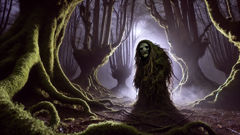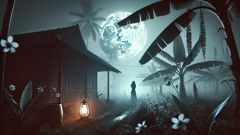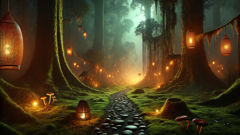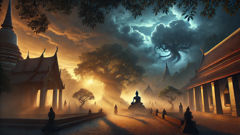Introduction
In the far south of Chile, where dense forests shroud the land and the sea’s breath lingers in morning mist, lies the Chiloé Archipelago—an island realm woven from salt, legend, and memory. Its ancient woodlands are thick with ferns and mosses, split by churning rivers and sunken paths, the air forever tinged with secrets. Here, on nights when the moon glows silver behind drifting clouds, and the wind sighs through the coigüe trees, people lower their voices and speak of things best left undisturbed. For in these woods, belief runs deep, and not all who walk beneath the tangled branches return unchanged. Some speak of encounters so strange, they blur the line between waking and dream—a tug on the soul from something both earthly and utterly beyond. Of all the tales spun in fireside hush, none chills the heart quite like the legend of the Trauco. He is neither spirit nor man, but something wilder: a small, hunched figure, face rough and ugly as gnarled roots, clothed in forest shadows. Yet his presence is powerful, commanding, and his gaze—so they say—carries a magic that cannot be denied. Women who wander alone may fall prey to his charm, their destinies rewritten with a single glance. Over generations, stories of the Trauco have shaped the rhythms of village life, explaining births and stirring caution in the hearts of the young. His legend is more than myth—it is woven into the soul of Chiloé, a warning and a wonder, a reflection of longing, shame, and the tangled beauty of wild places.
Whispers Among the Coigüe Trees
María had lived all her eighteen years in the village of Cucao, on the western fringe of Chiloé, where the forest met the restless Pacific. She was the eldest daughter of a fisherman and a healer, her life braided from the tides and the land. Like every child of the archipelago, she’d grown up with stories: of ghost ships that sailed fog-shrouded waters, of forest beings that sang men astray, and of the Trauco—most feared and most mysterious of all.
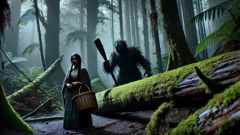
But María was practical, her mind sharpened by hardship. She knew how to trap hares and find edible roots, to hush her siblings when storms battered the thatched roof, to tend the sick with her mother’s tinctures. She’d heard the tales of the Trauco since she could toddle: warnings murmured as mothers bundled their daughters home at dusk, laughter at the edge of panic from boys daring each other deeper into the woods. The Trauco, with his club carved from luma wood and eyes that could pierce a soul—he was a story to keep girls in line, nothing more.
Still, even María felt a chill when the wind curled through the trees at night, and the old dog pricked its ears toward the darkness. There were things in these woods that no one could explain, footprints where no man should walk, strange calls after midnight. Sometimes, in the hush before dawn, she’d hear her mother’s whispered prayers, asking for protection from those who wore no human face.
In early autumn, when the rains eased and the mushrooms sprouted in velvet clusters, María began venturing farther into the woods. Her family needed extra roots and berries to see them through the coming winter. She carried her mother’s woven basket, sturdy boots, and a knife at her belt. She hummed to herself as she walked, breaking the silence, her breath rising in the cool air.
One afternoon, she strayed deeper than ever before, chasing the last sunlight through a tangle of bamboo and ferns. The forest was alive with birdsong, but as she pressed on, the air grew heavier, quieter. She paused to rest beside a fallen log, heart thumping, senses sharpened by the hush. It was then she heard it—a rhythmic tapping, like wood on wood, echoing through the trees.
A cold thrill ran through her. The tales always began with that sound—the Trauco, beating his club against the roots to announce his presence. María told herself it was just a woodpecker, but her feet refused to move. The tapping grew louder, closer. Then, from the shadows, he emerged.
The Trauco was smaller than she expected, barely reaching her shoulder. His body was broad and powerful, legs stumpy but quick. His face was hideous, twisted with deep lines and a mouth too wide, but his eyes—they glimmered with a strange, magnetic light. María could not look away. Her limbs grew heavy, her thoughts distant. The stories were true. She stood transfixed as he raised his club, not to strike, but to tap it gently on the earth—a summons that rippled through her bones.
He spoke no words. Instead, his gaze burned into hers, and in that moment, María felt every secret longing and shame swirl within her chest. Memories tumbled: stolen kisses in the barn, dreams of a life beyond the village, the ache of being seen and unseen. The Trauco’s power was not just in magic, but in knowing—he revealed what was hidden, casting it back like a mirror.
She managed to break away, stumbling back into the safety of sunlight and birdsong. But she could not forget the look in those eyes or the hunger it awakened. In the days that followed, María grew restless. She saw the Trauco’s shadow in every glen, heard his tapping in every gust of wind. Nights brought strange dreams, heavy with longing and dread.
When her mother noticed the change—a quietness, a distance—she pressed María for the truth. Tears spilled as she confessed her encounter. Her mother’s face blanched; she crossed herself, muttering blessings and warnings. “You must not return to that place,” she said, but her voice trembled with more fear than certainty. In Chiloé, the lines between belief and reality blur, and once seen, the Trauco is never far.
A Village in Suspicion
Word spread quickly in Cucao, as it always did when something strange touched one of their own. María’s mother swore her daughter to silence, but secrets were fragile things. The old healer shared her worries with a neighbor, and by dusk, whispers curled through every house like smoke.
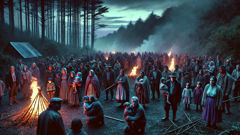
Women cast anxious glances into the woods, warning their daughters to stay close. Men muttered about curses and omens, recalling stories from their own childhoods—tales of girls found dazed and changed after venturing alone into the forest. The priest reminded his flock to cling to faith, yet even he locked his door and lit extra candles at night.
María tried to reclaim her life’s rhythm—gathering berries, tending to her siblings—but unease dogged her every step. Her dreams grew more vivid, filled with fog and flickering eyes. In the daylight, she doubted herself; by night, she feared what she might become. It wasn’t long before the first signs appeared—her body shifting, her appetite strange. The old women nodded knowingly: the Trauco had marked her.
Gossip swelled. Some villagers whispered that María must have courted the spirit’s favor; others pitied her, recalling times when misfortune had visited their own families. A few men, emboldened by drink and fear, spoke of hunting the Trauco down—though none dared set foot in the heart of the woods. Instead, they gathered at the edge, building fires and reciting prayers. The forest, unmoved, watched them with indifferent patience.
María’s father grew distant, guilt heavy in his eyes. He’d failed to protect his daughter, failed to keep the old beliefs at bay. Her mother clung to ritual, laying rowan branches at every window, whispering charms over María’s bed. But nothing could erase the certainty that settled over them: life had changed, as it had for so many before.
As weeks passed, María’s belly swelled, undeniable as the tides. The village response split in two—some offered help, sending broth and blankets; others crossed themselves and kept their distance. The priest delivered sermons about forgiveness and mystery. The girls of the village eyed the woods with new fear, while the boys grew bolder, staging midnight dares that ended in shrieks and laughter.
One evening, as dusk colored the sky a bruised violet, María slipped from her house and wandered to the forest’s edge. She stood among the ferns, listening to the deep hush, heart aching with questions she couldn’t voice. Was it magic or fate? Was she chosen or cursed?
In that stillness, she saw again those eyes, remembered the gravity of their gaze. The Trauco had changed her—not just in body, but in spirit. She realized she would carry this encounter all her days, a part of her as indelible as her name. In Chiloé, legends do not fade; they settle into the bones of the living.
The Child of the Forest
The seasons shifted as they always did on Chiloé—rains swelling rivers, winds scouring the hills, and mushrooms bursting from the damp soil. María retreated into herself, her world narrowed to a circle of family and a few steadfast friends. Her mother watched over her with anxious devotion, whispering old prayers and rubbing balm into her aching back.
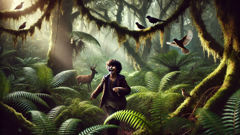
When her time came, it was a night thick with fog, the moon hidden and only the ocean’s distant roar to measure the hours. The birth was long and hard. The midwife—a stoic woman who’d delivered half the village—arrived with a basket of herbs and a bundle of red string. As María labored, she saw visions behind her eyelids: deep woods alive with silent watchers, a small figure waiting just out of sight. The midwife muttered words from an older tongue, words meant to ward off the Trauco’s lingering touch.
At dawn, María’s cries gave way to the first wail of her child—a son with dark eyes and a shock of wild hair. The women present exchanged glances, some superstitious, some awed. There was nothing monstrous about the boy; if anything, he seemed more alive than most children, as if the energy of the forest pulsed through him.
Rumors flared anew. Some claimed they saw the Trauco himself lurking near the house in the hours after the birth, eyes gleaming in the predawn gloom. Others insisted María had been blessed with a gift—her child would grow strong and wise, marked by the spirit of the woods. The truth became another story in a village built from them.
As María healed, she grew fiercely protective of her son. She named him Mateo, after her grandfather, and refused to let others treat him as anything less than human. But she couldn’t deny the strange connection he seemed to have with nature. He was happiest outside, toddling among ferns and stones, his laughter mingling with birdsong. Animals gathered near him—dogs, birds, even shy deer. Flowers seemed to bloom where he trod. The old women watched and shook their heads, whispering about fate and power.
Mateo’s childhood was not easy. Some villagers avoided him; others lavished him with gifts in hopes of earning favor from whatever force watched over him. Children teased him with nicknames—goblin’s son, forest child—but he met their taunts with calm curiosity. He grew tall and strong, his features more handsome than not, but with an intensity in his gaze that echoed the forest’s mystery.
María watched him grow, torn between pride and worry. She feared the old stories would follow him forever, that he’d never be seen for himself. But Mateo seemed untroubled by his origins. He spent hours in the woods, learning names of plants and birds, listening to the wind. He told his mother he could sense the spirits that moved beneath the trees, neither friend nor foe—simply part of the world’s hidden order.
As years passed, the village’s fear faded, replaced by respect for Mateo’s wisdom and kindness. Some said he could heal sick animals with a touch or guide lost children home through tangled woods. The legend of his birth softened into something less menacing—a reminder that even in the darkest tales, light finds its way.
Conclusion
Years wove onward in Cucao, each season laying new threads into the tapestry of legend and life. María’s tale faded from scandal to myth, repeated quietly to children on stormy nights or shared between lovers walking the edge of the woods. The Trauco remained a presence—sometimes whispered about in fear, other times in awe—his figure woven into every rustle of leaves or sudden hush among trees. Mateo grew into a man respected for his kindness and wisdom, living proof that what begins in shadow can flourish in light. For some, he was a symbol of hope; for others, a mystery that could never be fully explained. Yet the true legacy of the Trauco was not fear or shame, but an enduring reverence for Chiloé’s wildness and wonder. The villagers learned to listen to the woods—not just for danger, but for possibility. And so, beneath the arching coigüe branches and shifting mists, the legend lived on: a reminder that nature’s magic moves among us still, shaping destinies with a glance and carrying secrets as old as the roots themselves.

